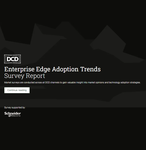The demand for data centers is experiencing strong growth, particularly within the retail colocation segment, both in terms of market size and the number of players involved.
This makes for a highly fragmented – highly competitive – marketplace, where the pressure is on vendors to stand out in an increasingly saturated sector.
“It puts the tenant in the driver’s seat,” said Patrick Donovan, senior research analyst at Schneider Electric. “It makes tenants more discriminating, more disconcerting. It creates a sense of urgency for vendors to somehow offer their tenants more value, more service, more support, to somehow differentiate themselves.”
With tenants seemingly spoilt for choice, Donovan believes the great differentiator lies in well-implemented, well-maintained infrastructure management software.
“Long gone are the days of having a couple of on-prem larger centralized data centers. Now your IT portfolio is spread out all over the place, it’s highly geographically distributed IT.”
Of course, the more sites there are to cover, the more there is to manage. Security becomes a bigger concern, and visibility, or lack thereof, becomes a major issue. This is where DCIM 3.0 comes in.
“Clients are asking things like, ‘Am I being efficient? What am I wasting? How in the world am I going to measure the sustainability impact of all this stuff?’ So, for us, to summarize these newer needs from clients, it's really a focus on security, sustainability, and transparency. They want to have visibility on everything that's going on within the colo with respect to their IT.”
It is these three pillars: Security, sustainability, and transparency, that separate DCIM 3.0 from its predecessors. But, as Donovan stresses during a conversation with DCD’s Emma Brooks, you only get out of it what you put in.
“A key aspect of using DCIM is to make sure that the map of assets, your digital twin, your representation of the data center in the software is accurate and up to date.”
Donovan explains that if the software map of resources is inaccurate, then all the calculations, recommendations, and outputs of that software become flawed from that point on. It’s a classic case of bad data in vs bad data out.
You also have to ensure that, when deploying DCIM, everyone is on board. For instance, if someone in management decides to deploy DCIM, without the buy-in or participation from the operations teams, no data is just as useful as inaccurate data.
“Everyone needs to accept DCIM as a tool and learn how it works,” said Donovan. “Another common mistake we see is that they install it and they haven’t necessarily even done any training on it.”
Schneider Electric offers both in-person and virtual DCIM training, which Donovan believes - if used correctly and collaboratively - could really help vendors not only differentiate themselves in a highly competitive market, but provide a better service to their tenants, too.
To find out more about how DCIM 3.0, watch the full DCD>Talk here.
More from Schneider Electric
-

Enterprise Edge Adoption Trends – Survey Report
A survey report based on research conducted by DCD looking at trends within enterprise Edge adoption
-

DCD>Talks Edge computing and infrastructure challenges of AI and the distributed cloud with Andres Vasquez, Schneider Electric
DCD's Claire Fletcher talks with Andres Vasquez of Schneider Electric on Edge computing and infrastructure challenges of AI and the distributed cloud.
-

DCD>Talks Demystifying the Data Center Industry with Mark Yeeles, Schneider Electric
Mark Yeeles joins us in the DCD>Talks studio at DCD>Connect | London to talk addressing the data center PR problem and how to show the industry in the best light.

